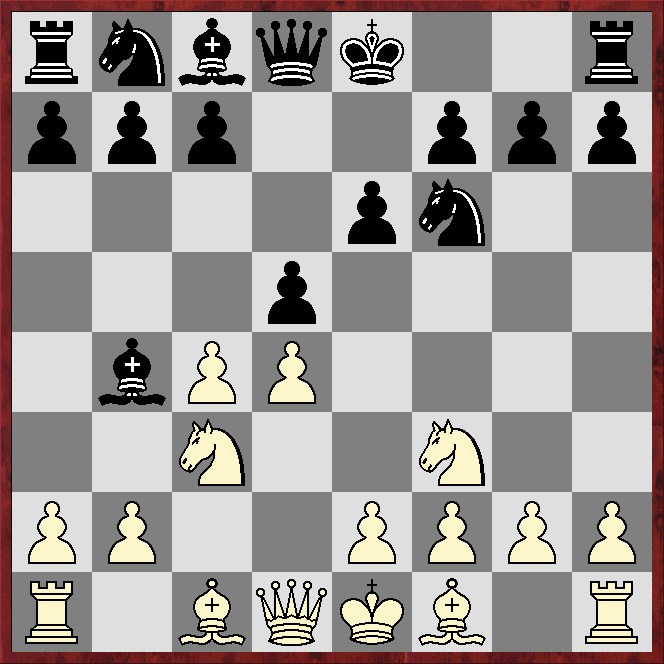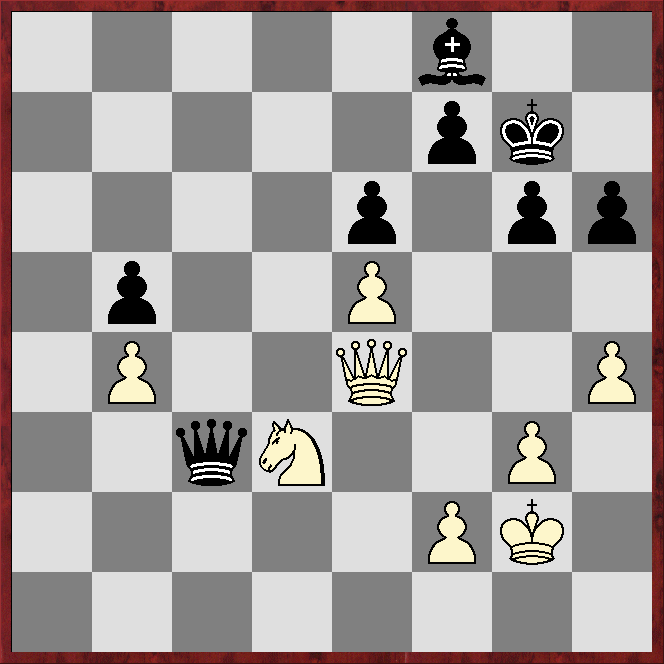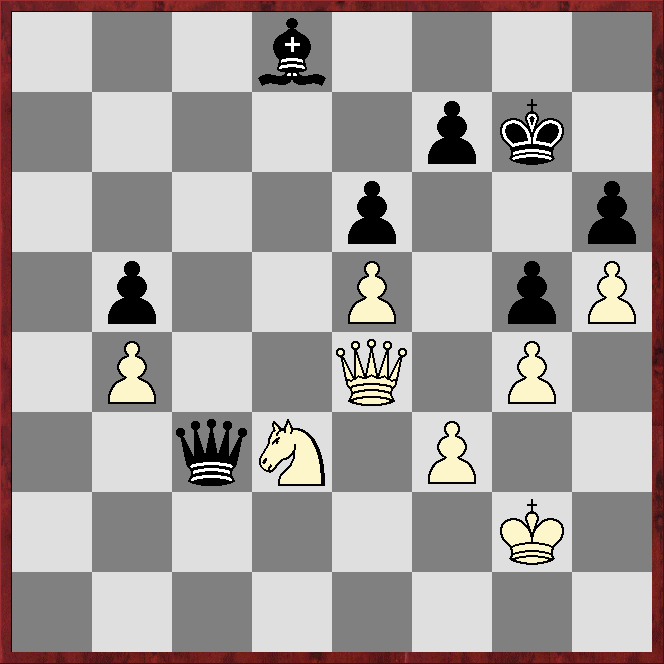Jo Primrose (2062) - Spanton (2277)
PC Gibbs Memorial Section A
QGD Ragozin
1.d4 d5 2.c4 e6 3.Nc3 Nf6 4.Nf3 Bb4
This is Black's third-most popular continuation in ChessBase's 2024 Mega database, behind 4...c6 and especially 4...Be7.
*****
*****
*****
*****
5.Bg5
This is commonest, but Stockfish16.1 and Dragon1 prefer 5.cxd5 and 5.Qa4+.
5...h6 6.Bxf6!?
Giving up the bishop-pair is the mainline, although Magnus Carlsen is among those who have tried 6.Bh4.
6...Qxf6 7.e3 0-0 8.Rc1 dxc4!?
Another strange-looking move, but again it is the mainline. The point, I believe, is that after ...
9.Bxc4
... Black can immediately hit the white centre.
9...c5 10.0-0
*****
*****
*****
*****
Black has the bishop-pair, but White is ahead on development and has two pawns against one on the two central files. The engines reckon the position is equal.
10...cxd4
This gets rid of the central majority.
11.Nxd4!?
Gaining a central space advantage with 11.exd4 is not popular.
11...Bd7 12.Ne4!?
Much more popular is 12.Qb3.
12...Qe5!?
There is just one example of this move in Mega24; the other 21 games saw 12...Qe7.
13.Qc2!?
This is probably a novelty. Michał Krasenkow (2620) - Grzegorz Gajewski (2615), Polish Championship (Warsaw) 2017, went 13.Qd3 Nc6 14.f4 Qa5 15.Nb3 Qb6 16.Rf3 Rad8, with a slight edge for Black, according to the engines (0-1, 60 moves).
13...Nc6 14.Nf3 Qc7 15.Bd3 Be7!? 16.a3 Rfd8 17.b4 a6 18.Nc5 Rac8 19.Bh7+ Kh8 20.Be4 Be8!?
*****
*****
*****
*****
Black still has the bishop-pair and has caught up in development, but White is a little more active. The engines reckon the position is equal.
21.Qb3 Qb8 22.Qb1 Rc7 23.Nb3 Bf6 24.h3 b6 25.Bd3 Qa7 26.Be2 Ne7 27.Rxc7 Qxc7
*****
*****
*****
*****
28.Rc1
28.Bxa6 is possible, the engines continuing 28...Nd5 29.Qc1 Qa7 30.Bd3 Ra8 with ...Qxa3 to come. If 29.Rc1 Qa7 30.b5, Black has 30...Nc7, with at least a slight edge, according to the engines.
28...Qa7 29.Nbd4 Kg8 30.Bd3 g6 31.Qb3 Kg7 32.Qb1 Bd7 33.e4!?
*****
*****
*****
*****
33...Kg8!?
Giving the dark-square bishop a retreat square.
34.e5 Bg7 35.Qb3 Qa8!? 36.Re1 Nc6 37.Be4 Nxd4!? 38.Nxd4 Qa7 39.Nf3
*****
*****
*****
*****
White has more space, but Black has pressure against the e5 pawn, and exchanges have meant more freedom for the bishops. The engines reckon Black is slightly better.
39...Rc8 40.Qe3 Bb5 41.g3 Qc7 42.Rd1!?
*****
*****
*****
*****
42...Bf8!?
42...Bxe5 can be met by 43.Bxg6, with equality, according to the engines. The text is the start of a plan to pressurise the white queenside.
43.Bd3 Ba4 44.Re1 a5 45.Ba6 Rd8 46.Be2 Rd5 47.Rc1 Qd8 48.h4 axb4 49.axb4 Kg7
Defending h6, to force White to defend b4.
50.Qe4 Bd1!?
Giving up the bishop-pair, but forcing exchanges in an attempt to exploit the weakness of the white b pawn in an ending.
51.Bxd1 Rxd1+ 52.Rxd1 Qxd1+ 53.Ne1
Not 53.Kg2? as 53...Qa4 wins a pawn.
53...b5 54.Kg2 Qb3 55.Nd3 Qc3
*****
*****
*****
*****
Knight and queen often work better together than bishop and queen, but here the latter pair has a fixed target at b4 (indeed all the white pawns are on dark squares). The engines reckon Black has the better side of equality.
56.g4 Be7 57.h5 g5 58.f3
White's kingside pawns are no longer potential targets for the bishop, but the white king looks a little less safe.
58...Bd8
This brings up a critical moment.
*****
*****
*****
*****
59.Nc5?!
59.Nc5?!
This is Dragon1's top choice for a long while, but it comes to agree with Stockfish16.1 that 59.Qe3 is better.
59...Bb6 60.Nd3
Dragon1 prefers 60.Nxe6+!? fxe6 61.Qg6+, but after 61...Kf8 62.Qxh6+ Ke7 63.Qf6+!? (on 63.Qxg5+ Kd7 the black king escapes the checks, and the engines agree Black's bishop is worth more than White's three extra pawns) Kd7 64.Qf7+ Kc6 65.Qxe6+ Kb7 66.Qd5+ Qc6 the checks run out, and the engines again agree the bishop is worth more than three pawns.
60...Bb6
*****
*****
*****
*****
61.Kg3?!
The engines reckon 61.Kf1 puts up stiffer resistance, but they much prefer Black, eg 61...Bd4 62.Ke2 Qc2+ 63.Ke1 Qb1+ 64.Ke2 Qg1 65.Kd2 Qg2+ 66.Kd1 Bc3 with continuing strong pressure (Black is winning, according to Dragon1; has the upper hand, according to Stockfish16.1).
61...Qa1 62.Qe1 Qa2 63.Qc3 Be3 64.Qe1 Bd4 65.f4!?
This is best, according to the engines, but it leaves the white king more exposed. After their second choice, 65.Nf2?!, play might run 65...Qb2 66.Nd3 Qc2 67.Nf2 Bc3, after which the b4 pawn falls sooner or later.
65...Qc2!?
The engines prefer 65...gxf4+, but the text is also good.
66.Qe4 Bg1!?
Again capturing on f4 was a serious alternative.
67.Kf3
White loses the queen and is mated after 67.fxg4?? Qh2+ etc.
67...gxf4 68.Kxf4 Qd1!?
The engines come to prefer this over other moves, once it is inputted on the board.
69.Kg3 Qf1 70.Kh4 Bh2 71.Qe3 Qh1 72.Qe1
The engines prefer 72.Nf2, but agree Black is winning.
72...Qf3 73.Qf2
Forced, but after ...
73...Qxf2+ 74.Nxf2 Bxe5
... White is a pawn down and could resign.
The game finished:
75.Ne4 f5 76.Nc5 Kf7 77.gxf5 exf5 78.Kh3 Kf6 79.Nd3 Bd6 80.Kg2 Ke6 81.Kf3 Kd5 82.Ke2 Kc4 0-1
A rare example of Black winning at correspondence chess.










No comments:
Post a Comment